
Maurits Cornelis Escher was a Dutch graphic artist who made mathematically inspired woodcuts, lithographs, and mezzotints. Despite wide popular interest, Escher was for most of his life neglected in the art world, even in his native Netherlands. He was 70 before a retrospective exhibition was held. In the late twentieth century, he became more widely appreciated, and in the twenty-first century he has been celebrated in exhibitions around the world.
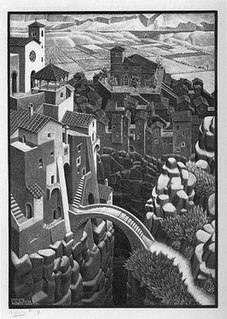
The Bridge is a lithograph print by the Dutch artist M. C. Escher, first printed in March 1930.
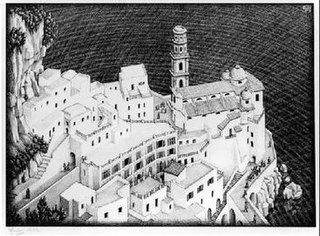
Atrani, Coast of Amalfi is a lithograph print by the Dutch artist M. C. Escher, first printed in August 1931. Atrani is a small town and commune on the Amalfi Coast in the province of Salerno in the Campania region of south-western Italy. Atrani is the second smallest town in Italy and was built right at the edge of the sea. This image of Atrani recurs several times in Escher's work, most notably in his series of Metamorphosis prints: Metamorphosis I, II and III.

Still Life with Spherical Mirror is a lithography print by the Dutch artist M. C. Escher first printed in November 1934. It depicts a setting with rounded bottle and a metal sculpture of a bird with a human face seated atop a newspaper and a book. The background is dark, but in the bottle can be seen the reflection of Escher's studio and Escher himself sketching the scene.

Hand with Reflecting Sphere, also known as Self-Portrait in Spherical Mirror, is a lithograph by Dutch artist M. C. Escher, first printed in January 1935. The piece depicts a hand holding a reflective sphere. In the reflection, most of the room around Escher can be seen, and the hand holding the sphere is revealed to be Escher's.

Regular Division of the Plane is a series of drawings by the Dutch artist M. C. Escher which began in 1936. These images are based on the principle of tessellation, irregular shapes or combinations of shapes that interlock completely to cover a surface or plane.

Still Life and Street is an unusual woodcut print by the Dutch artist M. C. Escher which was first printed in March, 1937. It was his first print of an impossible reality. In this artwork there are two distinctly recognizable realities bound together in a natural yet impossible way. Looked at from the window, the houses make book-rests between which tiny dolls are set up. Looked at from the street, the books stand yards high and a gigantic tobacco jar stands at the crossroads.
Metamorphosis I is a woodcut print by the Dutch artist M. C. Escher which was first printed in May, 1937. This piece measures 19.5 cm × 90.8 cm and is printed on two sheets.

Reptiles is a lithograph print by the Dutch artist M. C. Escher first printed in March 1943. It touches on the theme found in much of his work of mathematics in art.
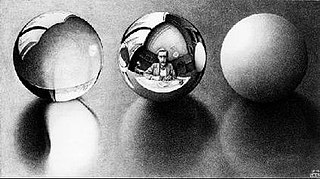
Three Spheres II is a lithograph print by the Dutch artist M. C. Escher first printed in April 1946.

House of Stairs is a lithograph print by the Dutch artist M. C. Escher first printed in November 1951. This print measures 47 cm × 24 cm. It depicts the interior of a tall structure crisscrossed with stairs and doorways.

Puddle is a woodcut print by the Dutch artist M. C. Escher, first printed in February 1952.
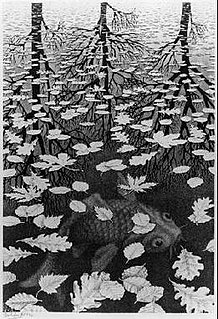
Three Worlds is a lithograph print by the Dutch artist M. C. Escher first printed in December 1955.
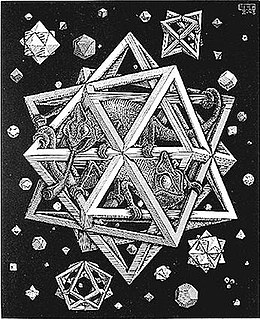
Stars is a wood engraving print created by the Dutch artist M. C. Escher in 1948, depicting two chameleons in a polyhedral cage floating through space.

Drawing Hands is a lithograph by the Dutch artist M. C. Escher first printed in January 1948. It depicts a sheet of paper, out of which two hands rise, in the paradoxical act of drawing one another into existence. This is one of the most obvious examples of Escher's common use of paradox.

Sky and Water I is a woodcut print by the Dutch artist M. C. Escher first printed in June 1938. of this print is a regular division of the plane consisting of birds and fish. Both prints have the horizontal series of these elements—fitting into each other like the pieces of a jigsaw puzzle—in the middle, transitional portion of the prints. In this central layer the pictorial elements are equal: birds and fish are alternately foreground or background, depending on whether the eye concentrates on light or dark elements. The birds take on an increasing three-dimensionality in the upward direction, and the fish, in the downward direction. But as the fish progress upward and the birds downward they gradually lose their shapes to become a uniform background of sky and water, respectively.

Print Gallery is a lithograph printed in 1956 by the Dutch artist M. C. Escher. It depicts a man in a gallery viewing a print of a seaport, and among the buildings in the seaport is the very gallery in which he is standing, making use of the Droste effect with visual recursion. The lithograph has attracted discussion in both mathematical and artistic contexts. Escher considered Print Gallery to be among the best of his works.

Still Life with Mirror is a lithograph by the Dutch artist M. C. Escher which was created in 1934. The reflection of the mirror mingles together two completely unrelated spaces and introduces the outside world of the small town narrow street in Abruzzi, Villalago, into internal world of the bedroom. This work of Escher is closely related to his later application of mirror effect in 1937 Still Life and Street. Escher manipulates the scale in different parts of the print to achieve the effect of smooth connection between worlds.
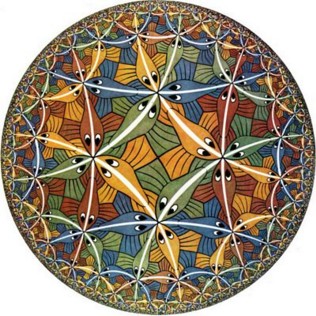
Circle Limit III is a woodcut made in 1959 by Dutch artist M. C. Escher, in which "strings of fish shoot up like rockets from infinitely far away" and then "fall back again whence they came".

Dragon is a wood engraving print created by Dutch artist M. C. Escher in April 1952, depicting a folded paper dragon perched on a pile of crystals. It is part of a sequence of images by Escher depicting objects of ambiguous dimension, including also Three Spheres I, Doric Columns, Drawing Hands and Print Gallery.



















